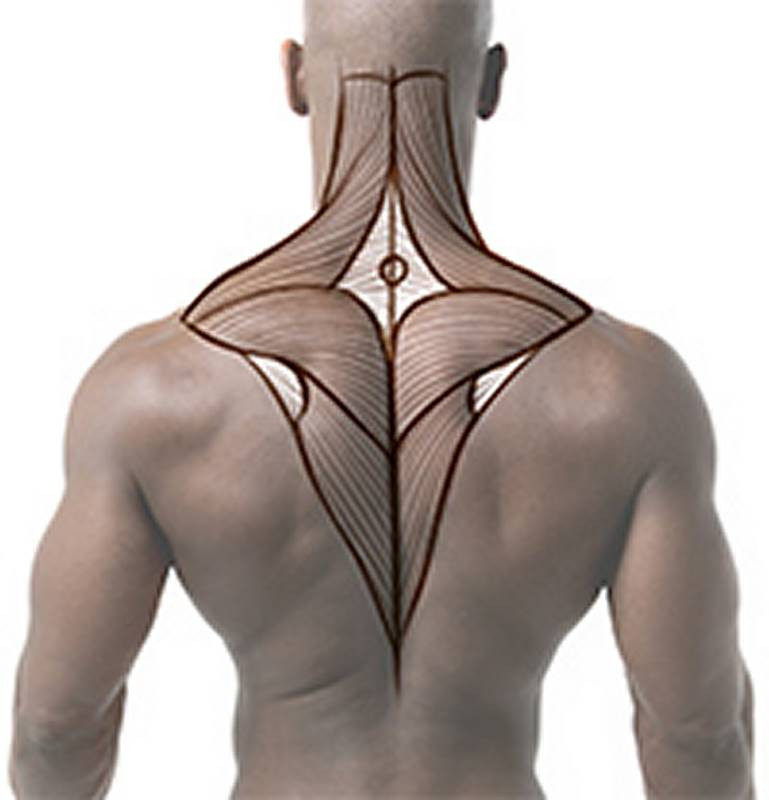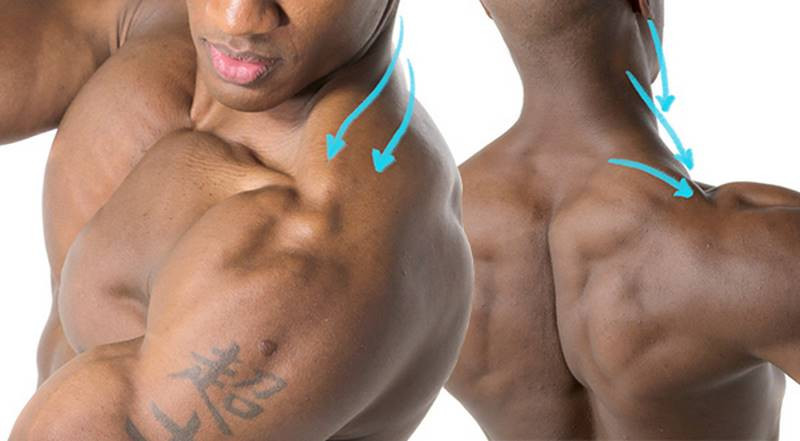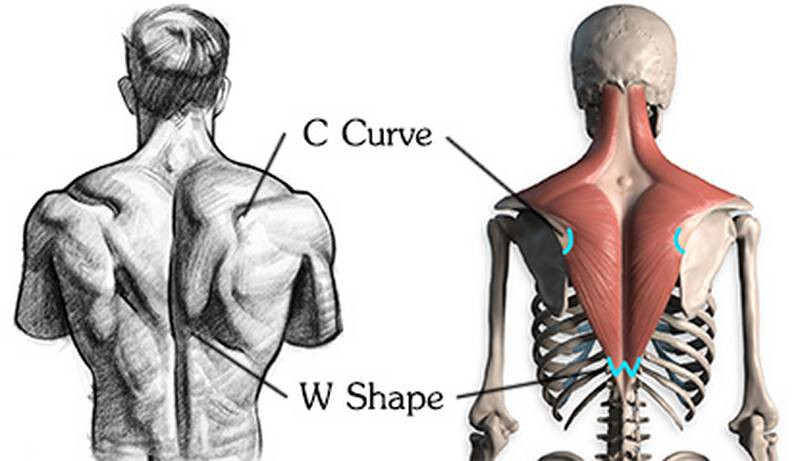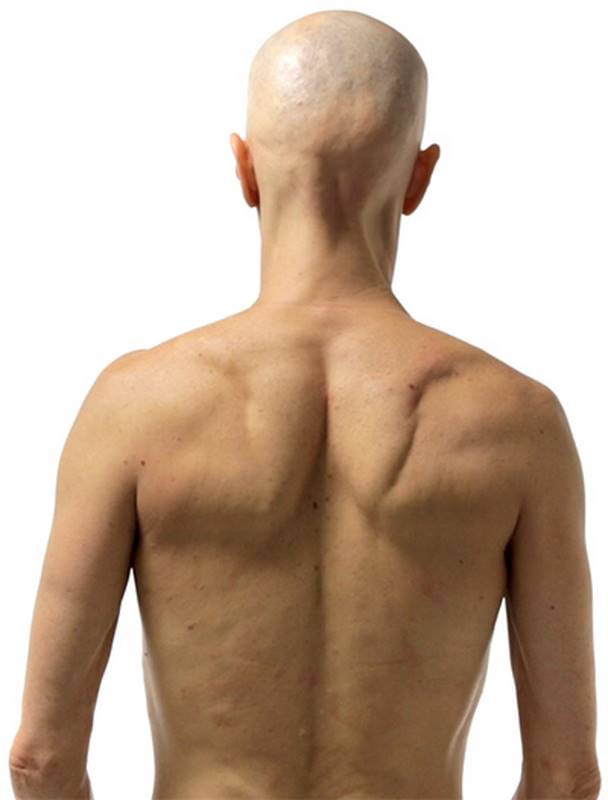It’s time to learn about the last two back muscles, the trapezius and rhomboideus.
Trapezius
From the front, it looks like a trapezoid shape, which is how it got the name "trapezius." From the back, however, it looks more like a kite or a spinning top. Remember learning about the shoulder girdle way back in the bone lessons? I hope so, because you'll need to be familiar with the scapula and clavicle for today's lesson.
The trapezius originates along the path of spine and inserts along the top of the shoulder girdle. That means it attaches to the spine of the scapula, the acromion process, and the clavicles. The trapezius moves the shoulders for things like shrugging or, well, anything with your shoulders, really.
The trapezius doesn't just raise your shoulders. It anchors above and below the shoulder blades, so it pulls the scapula closer to the spine and helps lower it too. A good indicator of the function is the direction of the muscle fibers. The fibers of the trapezius pull in many different directions.

It’s a pretty complicated muscle. Let’s simplify it a bit by splitting it into a diamond shaped tendon in the middle and 3 distinct portions around it – upper, middle, and lower. Let’s look at them in-depth.
Upper Portion
The upper portion is that trapezoid shape visible from the front of the body. It originates from the base of the skull, along the nuchal ligament and the 7th cervical vertebra, which is that bony landmark on the back of your neck. However, the muscle fibers don't reach all the way to the midline. They attach to a flat, diamond-shaped tendon which is centered around the 7th cervical vertebra. The upper portion of the trapezius attaches to the top half of that diamond shape.

The fibers flow downward and laterally to insert on the lateral third of the clavicles, as well as the acromion process. Sometimes the upper portion will also insert to a small part of the spine of the scapula.
In the images above, you can see how the fibers twist around to insert on the clavicle in the front.
The function of the upper portion is to elevate the scapula. But, if the scapulas are fixed, then the trapezius moves the head. When one side flexes, it tilts the head side ways. When both sides flex together, they flex the neck to bring the head back.
Middle Portion
The middle portion continues where the upper portion left off. It originates along the spine from T1 to T5, and reaches across the back to insert on the top plane of the spine of the scapula. The muscle fibers attach to the bottom half of that diamond-shaped tendon.
On a muscular or lean person the insertion along the scapula is quite dramatic. The muscle ends abruptly, so it bulges out above the insertion and clearly outlines the spine of the scapula. It’s one of the most recognizable features of the trapezius.
The muscle fibers of the middle portion are pulling more horizontally, from the spine out to the scapula. So, when this portion is flexed it retracts the scapula inward, pulling it toward the spine.
Lower Portion
The lower portion is the "tail" of the trapezius. It originates along the spine from T6 to T12, which is the lowest thoracic vertebra. The fibers go upward laterally to insert on the spine of the scapula again, but this time along the bottom edge.

There's a triangular tendon that wraps over the supraspinatus. The muscle fibers attach in an arc, so on the surface the muscle has a sharp C curve at the top medial corner of the scapula. It almost looks like someone removed a chunk with an ice cream scoop.
There's another triangular tendon at the bottom of the tail. Notice the "w" shape at the bottom of the tail? Each side of the trapezius will have it's own tail, since it's the muscle part that bulges on the surface.. Even though the tendon attaches all the way at T12, visually on the surface, it will appear to end earlier.
When flexed, this lower portion will pull the scapula downward, to lower the shoulder.
Rhomboid
Like the trapezius, the rhomboideus aka “rhomboid” is named after its shape. Unlike the trapezius, the rhomboid is very simple. Woohoo! It’s layered under the trapezius, so its form is softened. However, the rhomboid is thick enough that it shows through on the surface, so we definitely need to study it. Let’s take a look.
It originates on the spine, from the 4th or 5th thoracic to the 7th cervical and also on the nuchal ligament for the distance of one more vertebra. It reaches downward diagonally to insert on the medial edge of the scapula. You can see its rhombus-like shape.

So, notice how its direction of pull in this area is perpendicular of the trapezius. This crossing of the muscles can create some complexity on the surface and changes the way it looks depending in the articulation of the pose. But knowing how to track the muscles from origin to insertion will help us dissect what we’re seeing.
The rhomboid works with the upper portion of the trapezius to elevate the scapula, for the shrugging motion. It also medially rotates the scapula and hugs it tight against the rib cage. But mainly, the rhomboid retracts the scapula pulling it back toward the spine. That’s a lot of responsibility for a muscle most people don’t know about. Maybe that’s why rhomboids can get really thick.
In the next lesson, I will show you how to draw the forms of the upper back.












